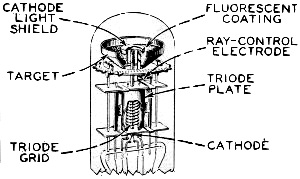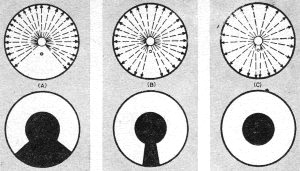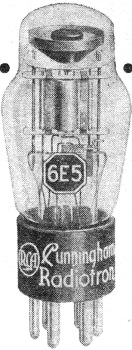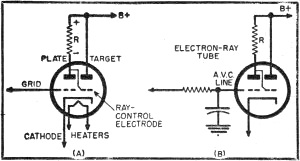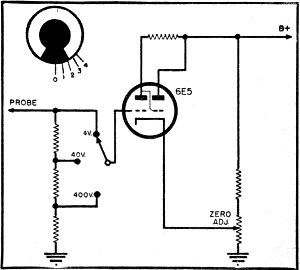The Tuning Eye - How It Works
|
|
Are you old enough to remember - or have you ever heard about - the "cat's eye" on old tube radios that was used for fine tuning of stations? The "eye" was generated by a special type of electron-ray vacuum tube like this 6E5 from RCA. A fluorescent disk at the top of the tube was caused to glow in accordance with the level of control voltage, as shown in figure 2. The electron-ray tube had to be mounted horizontally in the chassis so that the "eye" was visible from the front of the chassis. This article from the January 1955 edition of Popular Electronics magazine also describes how the electron-ray tube can be used as a voltmeter. As with most things, RCA 6E5 vacuum tubes can be found for sale on eBay. The original 1930's "Coke bottle" variety like the one in figure 3 usually cost a bit more than the newer versions with the constant diameter glass envelope. The Tuning Eye - How It Works
Fig. 1 - The target of the electron-ray tube is coated with a fluorescent chemical which glows when bombarded by electrons from the cathode. Photo courtesy of RCA. By E. Bukstein The electron-ray tube, or as it is more familiarly known, the "tuning eye," is a voltage indicator which, in many applications, replaces the far less rugged and far more costly meter movement. As shown in the drawing of Fig. 1, the plate of the tuning eye tube is circular and is known as the "target." This portion of the tube structure is coated with a fluorescent chemical which glows a vivid green color when it is bombarded by electrons from the cathode. Viewed from the top of the tube (which is usually mounted in a horizontal position so that the top, in reality, becomes the front) the target appears as a ring of green light. The dark disk in the center is a shield to block light from the cathode. The thin, vertical wire parallel to the cathode is known as the "ray-control electrode." If this electrode is made negative with respect to the target, it will repel some of the electrons. In this way, that portion of the target which does not receive electrons will not glow and will appear as a dark area or a shadow. The more negative the ray-control electrode is made with respect to the target, the wider this shadow becomes. This action is demonstrated diagrammatically in Fig. 2.
Fig. 2 - (A) The top view represents the top view of the tube (for simplicity, only target, cathode, and ray-control electrode are shown). The dotted arrows indicate electron paths from cathode to target. Ray-control electrode is negative and therefore repels electrons. That part of the target which receives no electrons does not glow. The appearance of the shadow is shown in the lower drawing. (B) Here the ray-control electrode is less negative than in (A). Electrons are not repelled as much and shadow is narrower. (C) When ray-control electrode is at same potential as target, electrons are not repelled. there is no shadow.
Fig. 3 - The electron-ray tube, in many applications, replaces a more delicate meter. When the electron-ray tube is to be used as a tuning indicator for a broadcast-type receiver, its grid is connected to the a.v.c. (automatic volume control) line as shown in Fig. 4B. When a station is properly tuned in on the broadcast receiver, the a.v.c. voltage will be at its maximum negative value. This negative voltage will then cut off the triode section of the tuning eye tube and there will be no shadow. However, if the receiver is mistuned or is "off station" to one side or the other, the a.v.c. voltage will be reduced. With less negative voltage on its grid, the triode will now draw plate current and produce a voltage drop across resistor R. Under these conditions, a shadow will appear on the target portion of the tube. Since the width of the shadow appearing on the target of the tube depends on the amount of voltage that is applied to the tube's grid, the electron-ray tube can be used as a simple and rugged voltmeter.
Fig. 4 - (A) The ray-control electrode is connected internally to the plate of the triode. The voltage drop across resistor R makes the ray-control electrode negative with respect to target. (B) When the electron-ray tube is used as a tuning indicator. its grid is connected to the a.v.c, line. When station is properly tuned in. a.v.c, voltage biases the grid to cut-off and the shadow on the eye tube disappears.
Fig. 5 - Since the width of the shadow depends on the amount of voltage applied to the grid the electron-ray tube can be used as a voltmeter. An arrangement of this type is shown in Fig. 5. The type 6E5 electron-ray tube, which is operated with a 1 megohm plate resistor and a 125 volt power supply, will give a zero shadow with -4 volts grid bias. At zero bias, the shadow angle will be 90 degrees. The variable resistor in the cathode circuit serves to bias the tube to cut-off and thus functions as the zero adjustment. The voltage divider and tap switch in the grid circuit provide the three ranges. The electron-ray tube will serve as a convenient indicator for alignment purposes in receivers which incorporate it. One type of indicator often used for alignment is a d.c. voltmeter to measure the a.v.c. voltage. Only a relative indication of this voltage is needed. The electron-ray tube as connected in a receiver gives just that. END
Posted November 2, 2022 |
|

